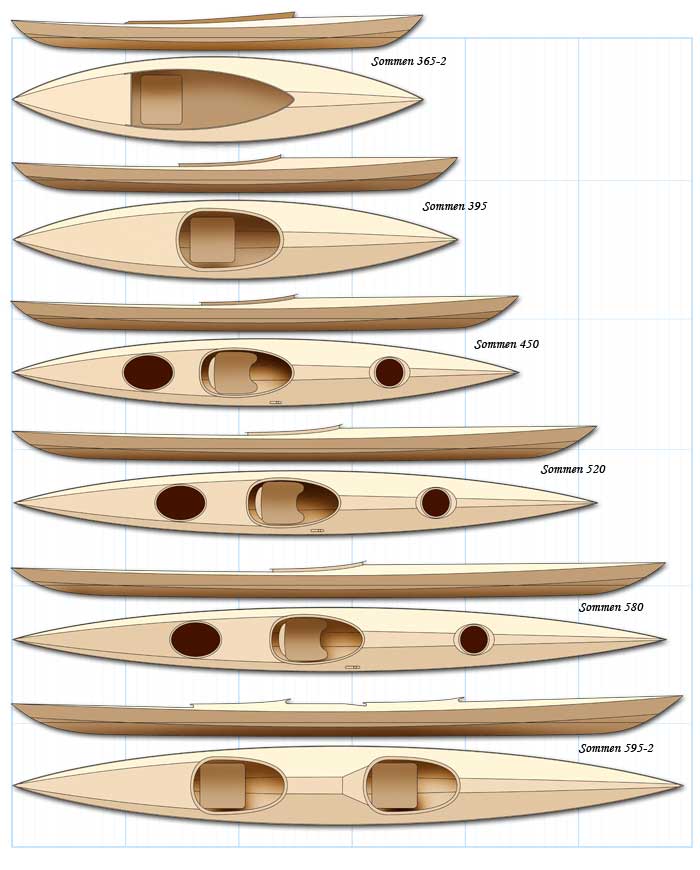Design assignments...
Latest updated Tuesday, November 8, 2022, 29 comments
Lately, I have got some questions about designing kayaks for commercial production, and some of them have led to design assignments.
Often my assignments include, apart from the design and the production drawings, also marketing illustrations, names and logos, presentation texts, etc.
(Click on the pics to enlarge)
Nordic Kayaks
 The first was Nordic Kayaks in Stockholm, calling me in fall of 2008 about a little help with the hydrodynamic tweaking of a new hybrid surfski-multisport hull. The work with what eventually would become the Fusion was initiated during the winter and was at first loosely based on my Sea Racer, which had fared quite well in tests against competitive surfskis during tests but morphed gradually into more of a pure surfski during the development. The focus was on achieving stability without losing speed compared with the top surfskis, and to achieving a comfortable bucket seat allowing for maximal paddling efficiency – and creating a surfski that would be outstanding in Nordic conditions (short wind waves up to 1,5 m rather than swell).
The first was Nordic Kayaks in Stockholm, calling me in fall of 2008 about a little help with the hydrodynamic tweaking of a new hybrid surfski-multisport hull. The work with what eventually would become the Fusion was initiated during the winter and was at first loosely based on my Sea Racer, which had fared quite well in tests against competitive surfskis during tests but morphed gradually into more of a pure surfski during the development. The focus was on achieving stability without losing speed compared with the top surfskis, and to achieving a comfortable bucket seat allowing for maximal paddling efficiency – and creating a surfski that would be outstanding in Nordic conditions (short wind waves up to 1,5 m rather than swell).
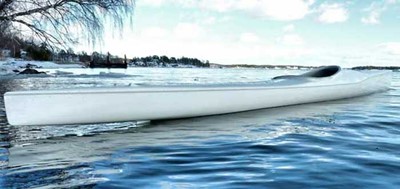
Fusion did very well and a multisport version was developed: Rapido. The same hull but shortened to 565 cm and with a traditional deck and cockpit.
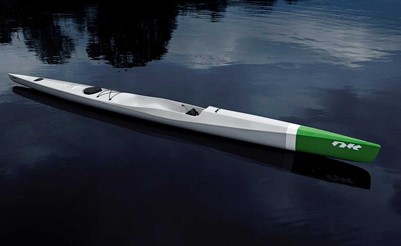 Later Rapido was produced as a pure surfski, that performed impressively in the short steep seas around our coasts.
Later Rapido was produced as a pure surfski, that performed impressively in the short steep seas around our coasts.
The picture shows Rapido 2.0, with a new visual profile and some refinements in the hull shape.
After a couple of years, we began, based on our experience with Fusion and Rapido, to plan for a new top-of-the-line surfski. The focus was still on comfort and paddling, but more on ultimate speed in different sea conditions than on stability.
Nitro is built for elite racing in rough sea conditions. Planned to be on the market in 2013.
Three different versions of different materials, weights, and prices are available – the top model in clear carbon.

At the same time, a more "rustic" surfski is emerging on the computer. Breeze will be shorter and wider, designed partly to bridge the gap between contemporary surfskis and sea kayaks for those tempted by exceptionally fast touring with a light load, and partly to provide a fast surfski for those not quite comfortable in a 43 cm hull. A narrow waterline means that Breeze is a very fast kayak unloaded, and thus slightly tippy (but not more so than that even beginners can get accustomed to it after a short time of practice). With camping gear, the hull sinks down on a slightly wider waterline and becomes a calm, safe and comfortable long-distance cruiser. Two kayaks for the price of one ;-)
 With increasing interest in surfskis, we saw the need for more models in the Nordic kayak line. Two surfskis in the "upper intermediate" range, Storm and Squall, were developed to offer competitive alternatives below the elite level. Storm is long and narrow, Squall slightly shorter and beamier – both intended for training, exercise, and competition.
With increasing interest in surfskis, we saw the need for more models in the Nordic kayak line. Two surfskis in the "upper intermediate" range, Storm and Squall, were developed to offer competitive alternatives below the elite level. Storm is long and narrow, Squall slightly shorter and beamier – both intended for training, exercise, and competition.
 For the 2015 season, we developed a shorter, wider surfski, Exrcize – intended for training, exercise, and touring. With sea kayak stability and hatch, it will be a performance-oriented touring kayak, as well as an ideal trainer and startup surfski for beginners.
For the 2015 season, we developed a shorter, wider surfski, Exrcize – intended for training, exercise, and touring. With sea kayak stability and hatch, it will be a performance-oriented touring kayak, as well as an ideal trainer and startup surfski for beginners.
During the last years, Fredrik Lindström has taken over more and more of the design work based on his extensive experience with surfskis. My role has been more of a discussion partner in the development process and assisting with visuals: logos, graphics, marketing illustrations, etc.
Seabird Designs
In 2009 Seabird Designs called and wanted to produce and market the Black Pearl. At first, I was very hesitant - the pearl was a wood kayak that you built yourself, and had by the inherent exclusivity achieved something of a legend status. But eventually, I realized that Seabird was intent on building a "real" Black Pearl – not a diluted commercial adaptation – and I drew two versions: one (LV) from my own prototype and suitable for paddlers up to approx 80 kg and 185 cm, and one slightly larger (HV), for bigger paddlers or those using it as a touring kayak.
 Black Pearl LV – the smaller model for paddlers up to approx 80 kg.
Black Pearl LV – the smaller model for paddlers up to approx 80 kg.
 Black Pearl HV – the larger model for heavier paddlers.
Black Pearl HV – the larger model for heavier paddlers.

The next step was when Seabird suggested a modern version of the famous Illorsuit kayak by Emanuele Korneliussen , that 50 years ago inspired the Anas Acuta and later Nordkapp and a host of followers. The result was the Qanik – an extremely maneuverable and quite fast kayak for touring and play. Qanik is well received all over the world (kajakr.net, Canoe&Kayak och Padling).
Qanik looks smart in black! 

Seapearl bridges the gap between Greenland-inspired kayaks and standard sea kayaks. Suited for those who like the Greenland style but not the tight cockpit, or find Black Pearl unnecessarily exciting, or find Black Pearl unnecessarily exciting, but are tempted by an easily rolled and highly maneuverable kayak, that still is beginner-friendly.
The introduction of these kayaks resulted in some buzz in the paddling community, since the Black Pearl by that time had become quite well known, and this meant more assignments for Seabird Designs. In the following year I designed one large and one medium size touring sea kayak, one mini sea kayak, one kayak for fishing and recreation, a line of training/racing kayaks, and a line of surfskis:
 Victory HV – a large expedition-style kayak: roomy, comfortable, and in spite of the volume quite fast and maneuverable. Surprisingly for me, even small and light paddlers have come to like Victory HV. A Victory LV, a smaller version is not yet in production.
Victory HV – a large expedition-style kayak: roomy, comfortable, and in spite of the volume quite fast and maneuverable. Surprisingly for me, even small and light paddlers have come to like Victory HV. A Victory LV, a smaller version is not yet in production.
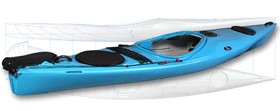 Discovery – is a handy mini sea kayak, that can do most of the things expected from a standard-size kayak. Top speed is of course not all that impressive, but in normal cruising speeds nothing of this is noticeable. Stability is not "beginner-maximized", but a thoroughly considered balance between initial and secondary stability that will not bore experienced paddlers – while rank beginners may need an hour or so before feeling confident in waves. A kayak to gain confidence and competence in. From Norwegian Playak: "Get out onto the water with ease: the Discovery provides it all in one neat little package! The kayak is responsive and stable ... light and very easy to handle ... This mini sea kayak is exactly what you need for exploring open, choppy waters on the sea; the lull of lazy rivers and wild beauty of lakes."
Discovery – is a handy mini sea kayak, that can do most of the things expected from a standard-size kayak. Top speed is of course not all that impressive, but in normal cruising speeds nothing of this is noticeable. Stability is not "beginner-maximized", but a thoroughly considered balance between initial and secondary stability that will not bore experienced paddlers – while rank beginners may need an hour or so before feeling confident in waves. A kayak to gain confidence and competence in. From Norwegian Playak: "Get out onto the water with ease: the Discovery provides it all in one neat little package! The kayak is responsive and stable ... light and very easy to handle ... This mini sea kayak is exactly what you need for exploring open, choppy waters on the sea; the lull of lazy rivers and wild beauty of lakes."
Fisherman 12 was a successful design, which led at least one of its competitors to feel threatened ;-)
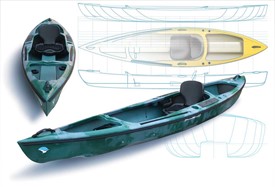 Fisherman 12 – a fishing kayak with a tunnel hull:
Fisherman 12 – a fishing kayak with a tunnel hull: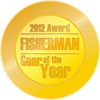 stable, comfortable, and maneuverable. The tunnel hull has several interesting advantages for this kind of kayak: it is faster, it tracks better and the initial stability is increased compared to a similar standard hull. Fisherman is designed and built to be an efficient and versatile platform for fishing, hunting, wildlife, etc.
stable, comfortable, and maneuverable. The tunnel hull has several interesting advantages for this kind of kayak: it is faster, it tracks better and the initial stability is increased compared to a similar standard hull. Fisherman is designed and built to be an efficient and versatile platform for fishing, hunting, wildlife, etc.
...and then Seabird thought it was time for a line of surfskis:
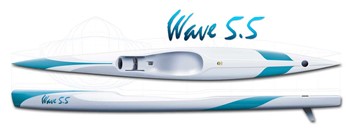 Wave 5.5 is the first of the three I designed for Seabird – an entry-level surfski, stable as a sea kayak and with a potential for long-distance touring. German outdoor company Denk has this to say after testing: "Wave 5.5 is designed for sporty kayaking in the open sea, but also wins on the flat water with an enormous speed potential and unexpectedly large initial and secondary stiffness. In addition, the ergonomic seating position is very comfortable."
Wave 5.5 is the first of the three I designed for Seabird – an entry-level surfski, stable as a sea kayak and with a potential for long-distance touring. German outdoor company Denk has this to say after testing: "Wave 5.5 is designed for sporty kayaking in the open sea, but also wins on the flat water with an enormous speed potential and unexpectedly large initial and secondary stiffness. In addition, the ergonomic seating position is very comfortable."
 The 5.5 Wave was soon followed by Wave 6.1 – a medium-level ski for those who prefer a little more top speed and can handle a little less stability. Paddling.net: "Wave 6.1 is a forgiving surfski, trading very little of the top speed for more stability. Medium rocker means good performance in waves and on flat water and it is intended for intermediate paddlers, racing, training, and light fast touring."
The 5.5 Wave was soon followed by Wave 6.1 – a medium-level ski for those who prefer a little more top speed and can handle a little less stability. Paddling.net: "Wave 6.1 is a forgiving surfski, trading very little of the top speed for more stability. Medium rocker means good performance in waves and on flat water and it is intended for intermediate paddlers, racing, training, and light fast touring."
 ...and Wave 6.4 – an all-out elite ski with winning potential. The names indicate loa in meters. The surfskis share a balanced general performance profile – works fine surfing large waves as well as on flat water, but are not exclusively biased at any extreme (except maybe speed ;-)
...and Wave 6.4 – an all-out elite ski with winning potential. The names indicate loa in meters. The surfskis share a balanced general performance profile – works fine surfing large waves as well as on flat water, but are not exclusively biased at any extreme (except maybe speed ;-)
...and talking about speed – a line of training/racing/touring kayaks:
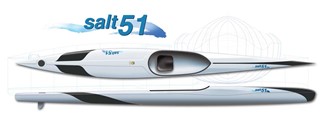 Salt 51 is a light and fast racing/training kayak with low initial stability and is designed for experienced paddlers. The seat, rudder system, and cockpit configuration are the same as in racing kayaks. German outdoor company Denk again: "Salt 51 is super fast! With a low initial stability is not the first choice for beginners, but experienced paddlers have a lot of fun."
Salt 51 is a light and fast racing/training kayak with low initial stability and is designed for experienced paddlers. The seat, rudder system, and cockpit configuration are the same as in racing kayaks. German outdoor company Denk again: "Salt 51 is super fast! With a low initial stability is not the first choice for beginners, but experienced paddlers have a lot of fun."
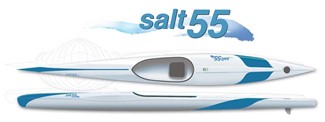 Salt 55 has a similar hull as Salt 51, but is a couple of cm wider, and is designed for beginners on flat waters or intermediate paddlers, training in winter or wave conditions. The names indicate the width in cm.
Salt 55 has a similar hull as Salt 51, but is a couple of cm wider, and is designed for beginners on flat waters or intermediate paddlers, training in winter or wave conditions. The names indicate the width in cm.
The most stable model in the line, Salt 59, is the older Touring, which was updated and relaunched with a new visual design and a new name.
The next project for Seabird is a line of fast-touring kayaks for ambitious long-distance paddlers. The plans are to produce three singles and three doubles. The first: M and M2, will be ready for the Nürnberg show in September 2013, with more coming during 2013. The line has yet no name. we are thinking hard, both in Lund and in Tallinn – and the images below are preliminary Photoshop renderings.
Update! Thinking is done and the name is (drum roll!) NORDR (here are my thoughts on the kayaks and the name).
 The inspiration for the hull shape and configuration is my Njord and Frej. Nordr S is 507 cm and Nordr M 533 cm.
The inspiration for the hull shape and configuration is my Njord and Frej. Nordr S is 507 cm and Nordr M 533 cm.

 The first K2 for Seabird is a stable and roomy kayak with a performance profile that should appeal to even beginners. With the inspiration from Njord (but much wider), it should be maneuverable, fast in touring speeds, and safe and comfortable in waves.
The first K2 for Seabird is a stable and roomy kayak with a performance profile that should appeal to even beginners. With the inspiration from Njord (but much wider), it should be maneuverable, fast in touring speeds, and safe and comfortable in waves.
 A coming K2 will be a long and narrow cruising rocket for intermediate to experienced paddlers: 640 cm loa.
A coming K2 will be a long and narrow cruising rocket for intermediate to experienced paddlers: 640 cm loa.
On the digital drawing table, I have start-up sketches for en long, narrow, and very capable single tourer, with the potential for sea racing as well. There are also plans for another large expedition K2 with a large midship hatch that can be used as a cockpit for kids. But more about that later...
Axis Kayaks
A new player, Axis Kayaks in Norway, wanted a line of kayaks/surfskis, primarily aimed at paddlers smaller than the "industrial norm" (185 cm and 80 kg).  At the same time, there should be no compromises with seaworthiness – think unprotected Norwegian west coast – and with a touring speed as good as the shorter waterline permits.
At the same time, there should be no compromises with seaworthiness – think unprotected Norwegian west coast – and with a touring speed as good as the shorter waterline permits.
 Another idea was to combine the qualities of sea kayaks and surfskis in one hull shape and offer this with both a standard sea kayak cockpit and an open surfski cockpit.
Another idea was to combine the qualities of sea kayaks and surfskis in one hull shape and offer this with both a standard sea kayak cockpit and an open surfski cockpit.
 The first off the production line are three kayaks and two surfskis – Axis X4 and S4: 505x56 cm, X3: 495x54 cm, X2, and S2: 460x54 cm (X is the kayak and S the surfski).
The first off the production line are three kayaks and two surfskis – Axis X4 and S4: 505x56 cm, X3: 495x54 cm, X2, and S2: 460x54 cm (X is the kayak and S the surfski).
More info on the presentationsnotis 130505 och på Axis site.
Kano- og Kajakvœrkstedet
Recently I began developing production versions of Frej and Njord for Danish producer/retailer Kano- og Kajakverkstœdet. First out is Frej (with a bit of luck in the summer of 2015), soon to be followed by a shorter version of Frej and the Njord.
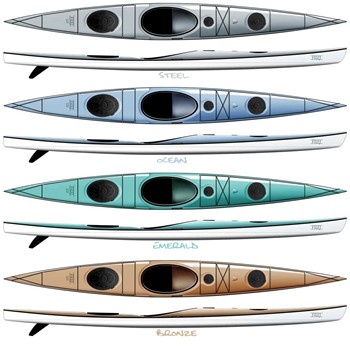 The objective is to get as close as possible to the wood strip versions, given the constraints of production materials and methods: unavoidable is that the production models are a bit heavier and lack a little of the structural stiffness of wood/fiberglass/epoxy.
The objective is to get as close as possible to the wood strip versions, given the constraints of production materials and methods: unavoidable is that the production models are a bit heavier and lack a little of the structural stiffness of wood/fiberglass/epoxy.
These sketches are design studies, which may provide a hint on where we may end up in the discussions on aesthetics. But the final design may look differently: a refined version of these, or something quite different if a brilliant idea pops up.
First out was Frej 504, a kayak suitable for paddlers up to approx 185 cm 85 kg. A year later came Frej 534, a slightly larger version (the number is the LOA in cm) – big paddlers liked the Frej 504 but found it a bit tight ;-)
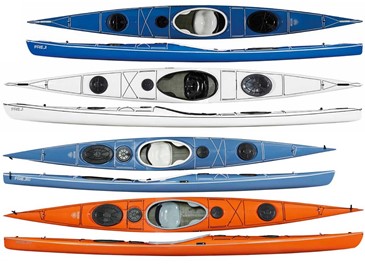 Yet another year later we got requests from English paddlers for a heavier hull layup – on some English coast sections you have to launch from cliffs/rocks in challenging weather. To fit BCU requirements these "Pro" versions also got an additional hatch on the back deck and industry-standard plastic handles in the stem and stern.
Yet another year later we got requests from English paddlers for a heavier hull layup – on some English coast sections you have to launch from cliffs/rocks in challenging weather. To fit BCU requirements these "Pro" versions also got an additional hatch on the back deck and industry-standard plastic handles in the stem and stern.
So here is the line for 2018. Frej 504, Frej 534, Frej 504 Pro, and Frej 534 Pro – available in a lot of colors and combinations, that can be ordered in almost whatever way you want.
New kayaks from China coming in 2016
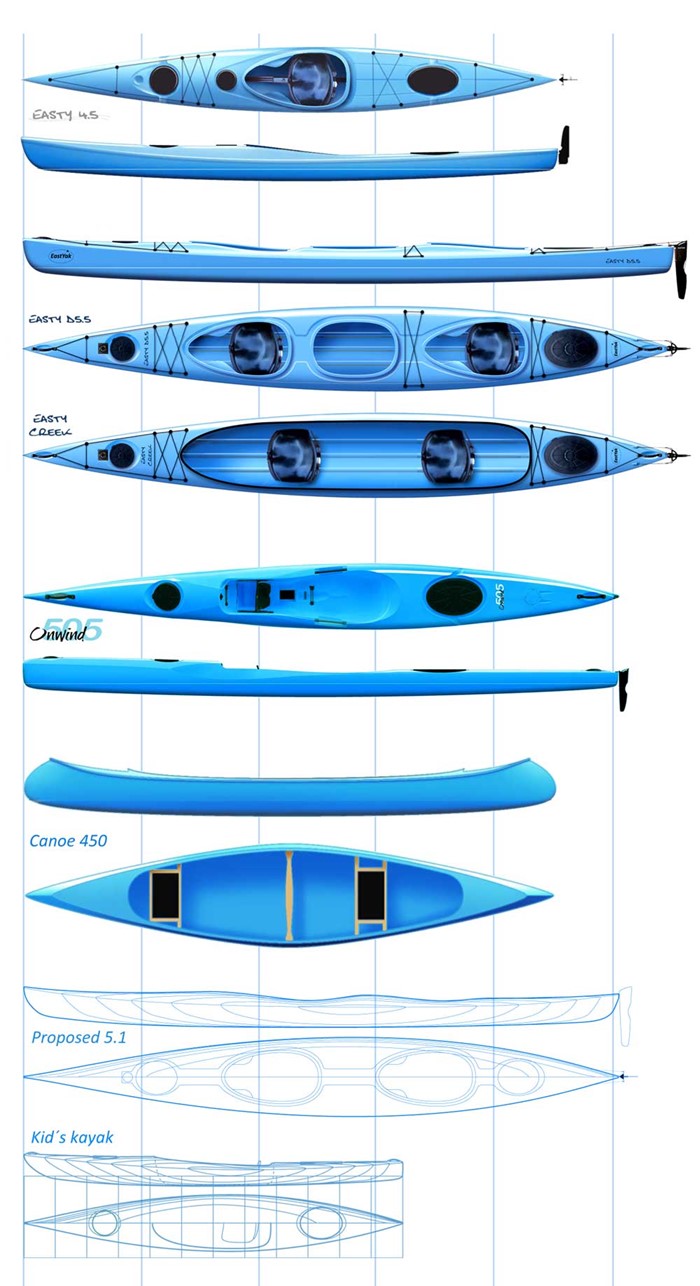 Together with a new Chinese company, specializing in different thermoplastic manufacturing processes, I have developed two kayaks, that is more mainstream than most of my other kayaks.
Together with a new Chinese company, specializing in different thermoplastic manufacturing processes, I have developed two kayaks, that is more mainstream than most of my other kayaks.
Economy kayaks must attract the intended buyer immediately – a low price means very little time for a salesperson to spend on teaching a customer the finer points of paddling. The buyer must feel confident (meaning that the kayak must look the way s/he "thinks normal" kayaks do) and it must have something that sets it apart from the competition.
I spend a lot of time and effort on looks and comfort (those things that are immediately evident in the shop), and on those performance qualities that I favor: my kayaks should feel quick, responsive, and easily handled – even a first-time paddler should be in control and have fun. They should not be too stable (unless the market is rentals on a hotel beach) since stable kayaks normally are dull and lack the potential for developing paddling skills. Beginner is a short-term condition with the right kayak.
More info is coming.
Petruskajak
Through the years I have designed or adjusted a number of kayaks for Petruskajak in Tranås/Sweden. The most talked-about is a line of Black Pearls for quick and easy amateur building with prefabricated plywood panels – they can be built in 8 days by everyone, regardless of skills (or lack of) or previous experience. Valter Vilör has written about his participating in a building class – only in Swedish but lots of pics!
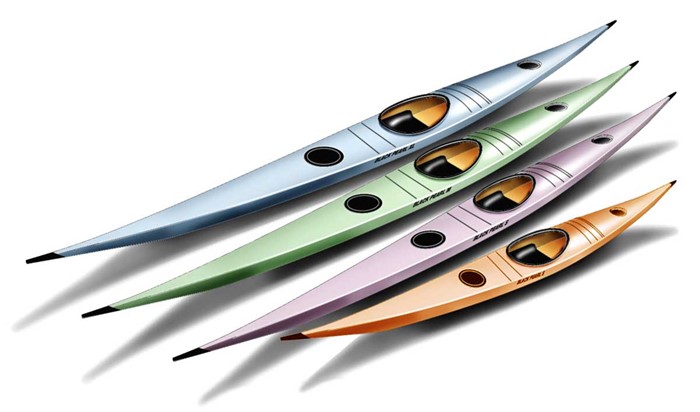
...and a new kayak for Petrus and his 8-day classes in plywood construction – this time yet another version of the Illorsuitkayak, adjusted for the flat panel construction. Since the original Illorsuit was a hard-chined skin-on-frame kayak, it means that Alleq, as the name will be, is actually closer to the original than the more modernized: Anas Acuta and Qanik. If that is an advantage or a disadvantage is up to the user.

As with Sommen and Black Pearl, Alleq will be available as an 8-day building class at Petrus in Tranås or at Niklas in Pargas, Finland. For interested builders in the US northeast, Dan Caouette at Clear Stream Custom Watercraft will be offering the same, and a boatbuilder in northern Germany is also interested. There will be two sizes: Alleq 550 and Alleq 520 (the number indicating the length in cm) with the beam and deck height adjusted in proportion to the length.
Also Frej is available from Petruskajak – in several sizes to fit all paddlers...

...and Panthera in two sizes.

... and a Njord vill soon be available.
The kayaks named Sommen were also suggested by Petrus: a line of kayaks, starting with a wide and stable fishing kayak (Sommen 395), that soon was a full line of kayaks – all designed for fast and efficient plywood construction, but without compromising looks or performance.
Launching reports: Sommen 395 and Sommen 450...
